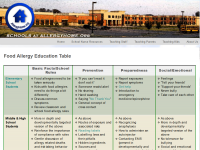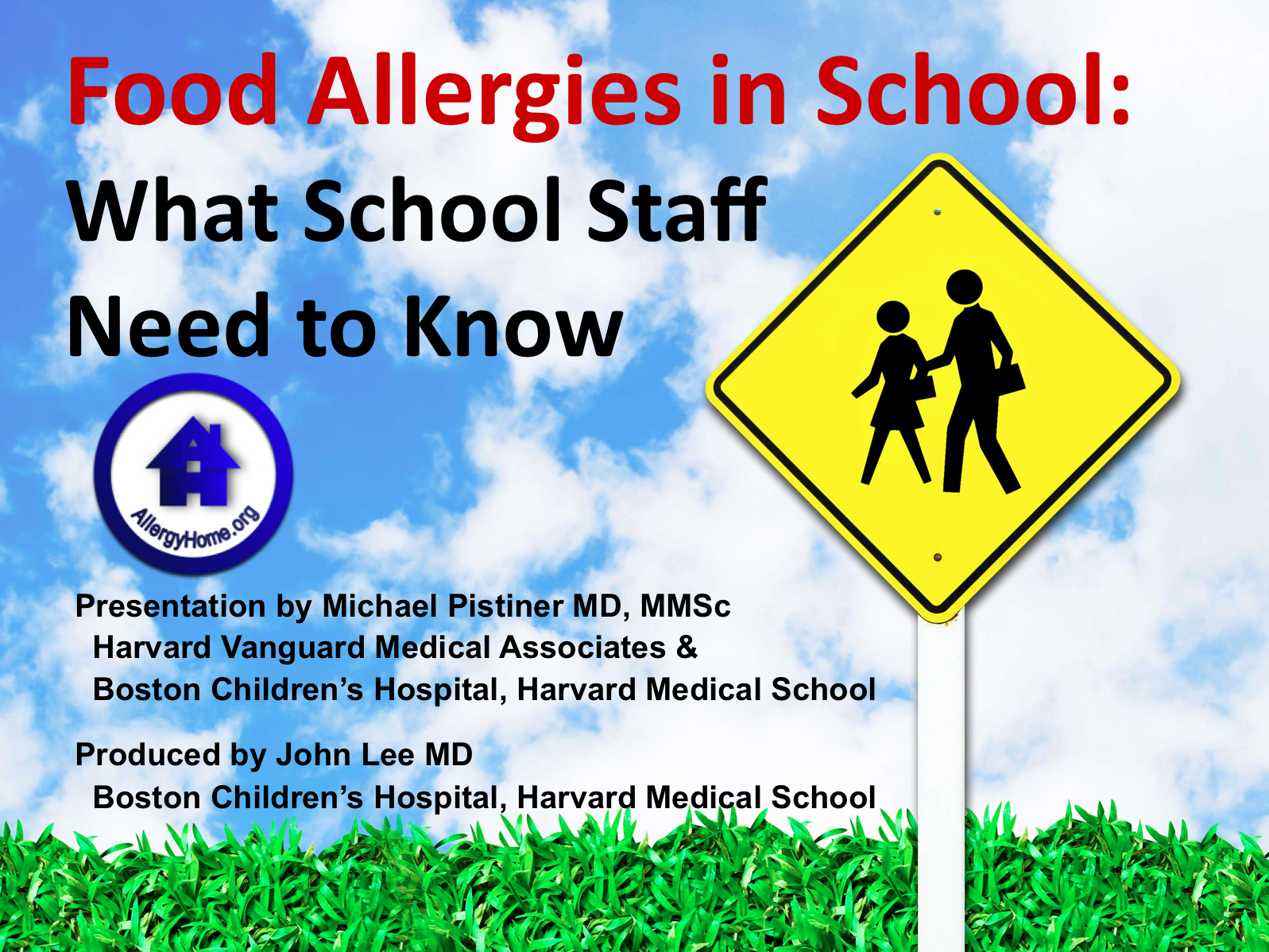| Type of Exposure | Relevant Facts | Practical Challenges | Practical Interventions* |
|
Oral Exposure
|
• There can be “hidden ingredients” in foods. • Labels and ingredients can change without warning. [1] • Items with advisory labels can contain allergens.[2] • Trace amounts can cause severe allergic reactions. • Allergens can be detectable in saliva.[3] • All children are protected by law to have a right to a free and appropriate education in the least restrictive environment. • Cross contact is presence of unintended allergen[1,3] – Allergen contact with surfaces, food, and saliva are common sources.
– Exposure by mouth or mucus membranes is a common cause of reactions. |
• Difficult to monitor outside food, especially if not labeled. • Reading labels takes training, pre-planning, assigned personnel, and time allowances. • Celebrations are common source of unlabeled food and cross-contact risk. • Majority of allergic reactions in school start in classrooms.[4] • Allergic child can be targeted for being cause of potentially unpopular accommodations. • Risk of bullying/teasing. [5] Additional consideration for pre-school/early elementary
• Young children can pass saliva to each other via age appropriate exploration.[3, 6]
• Some schools children eat in their classrooms/ learning environments.
• Supervision during meal/snack time dependent on resources and staff.
Additional consideration for adolescent/teenage students
• Older students under less supervision and more reliant on self-management.
• Risk-taking, sense of “invincibility”, peer pressure, bullying. [7,8] |
• Non-food celebrations, activities, and rewards. • Limited and pre-screened food projects in classrooms that do not contain the allergen; parent notification of all food projects or activities. • Scrutiny of chosen foods before use. • Safe snack stash in classrooms that allow food. • Fresh fruits and vegetable snack alternatives. • Adult assistance for food allergic children in selection of safe foods from cafeteria lines. • No sharing or trading of food, drinks, or personal items. • Appropriate cleaning of high-touch surfaces and hands. • Consider encouraging parents of allergic children to send in all foods for child. • Parent and student community education to create supportive environment. • Encouragement to report any bullying/harassment. • No eating on school bus (exception for children medical conditions). Additional consideration for pre-school/early elementary
• Pre-school and lower elementary: no foods in classroom or selective allergen restriction as needed.
Additional consideration for adolescent/teenage students
• Periodic check-ins to ensure continued self-management.
• Encouragement to report any bullying/harassment. • Support and continued education by school nurse and staff. |
|
Skin Exposure
|
• Isolated skin contact on intact skin did not cause severe or systemic reactions when studied, although skin reactions can occur.[9,10]
• Soap and water, and commercial hand wipes are effective for cleaning hands or surfaces, eg, table tops.[11]
• Hand sanitizers are NOT effective in removing allergen protein residue.[11]
• Young children frequently place their hands and objects in their mouth.[6]
Age 1-2 yrs.: ~80 times/hr Age 2-5 yrs.: ~40 times/hr • Adults touch their eyes, nose, and mouth regularly.[12] |
• Limited resources and manpower to clean allergens and prevent cross-contact. • Some non-edible items contain food allergens; eg, finger paint, play dough, shaving cream, paste, bean bags, furniture, pet food, bird feed.[29] • Skin exposure that can result in mucosal exposure in adults and children (eyes/nose/mouth). Additional consideration for pre-school/early elementary
• Skin exposure that can quickly turn into mucosal exposure or oral ingestion.[6,12]
• Less effective cleaning skills (hands or eating surfaces).
|
• Same avoidance strategies as oral exposure above. • Frequent hand washing with soap/water or wipers before and after food handling or whenever hands are dirty. • Appropriate cleaning of eating areas. Additional consideration for pre-school/early elementary
• Same avoidance as above.
• Adult supervision of hand cleaning. • Adult responsibility for cleaning surfaces, toys, bus seats, etc. |
|
Inhalation Exposure
|
• Volatile organic compounds, not proteins, cause odor. [13] • Proteins cause most allergic reactions.[9] • Inhaling vaporized proteins from active cooking can cause severe allergic reactions and death.[9, 14, 15] • Most inhalation is not fatal.[14] | • Projects/experiments involving burning/heating of allergens. • Field trips, volunteering, or internships in areas where foods are actively cooking or aerosolized if known or at risk for food allergy. • Activities involve using food powders or grinding/crushing fresh foods. |
• No activities that involve cooking foods, or using flours, powders and other small particles of food that can go up in the air.[9,13,14]
• No food-related science experiments or classroom activities involving allergen. • Prior clearance from principal and notification of school nurse for all field trips, especially in classes with known food allergic children. |
1. Muñoz-Furlong A. Daily coping strategies for patients and their families. Pediatrics. 2003;11(3):164-166.
2. Hefle SL, Furlong TJ, Niemann L, Lemon-Mule H, Sicherer S, Taylor SL. Consumer attitudes and risks associated with packaged foods having advisory labeling regarding the presence of peanuts. J Allergy Clin Immunol. 2007;120(1):171-176.
3. Maloney JM, Chapman MD, Sicherer SH. Peanut allergen exposure through saliva: assessment and interventions to reduce exposure. J Allergy Clin Immunol. 2006;118(3):719-724.
4. McIntyre CL, Sheetz AH, Carroll CR, Young MC. Administration of epinephrine for life-threatening allergic reactions in school settings. Pediatrics. 2005;116(5):1134-1140.
5. Lieberman JA, Weiss C, Furlong TJ, Sicherer M, Sicherer SH. Bullying among pediatric patients with food allergy. Ann Allergy Asthma Immunol. 2010;105(4):282-286.
6. Tulve N, Suggs JC, McCurdy T, Cohen E, Moya J. Frequency of mouthing behavior in young children. J Expo Anal Environ Epidemiol. 2002;12(4):259-264.
7. Sampson, M.A., Munoz-Furlong, A., Sicherer, S.H. Risk-taking and coping strategies of adolescents and young adults with food allergy. J Allergy Clin Immunol. 2006 Jun;117(6): 1440-5. Epub 2006 May 11
8. Monks H, Gowland MH, MacKenzie H, et al. How do teenagers manage their food allergies? Clin Exp Allergy. 2010;40(10):1533-1540.
9. Simonte SJ, Ma S, Mofidi S, Sicherer SH: Relevance of casual contact with peanut butter in children with peanut allergy. J Allergy Clin Immunol. 2003;112(1):180-182.
10. Wainstein BK, Yee A, Jelley D, Ziegler M, Ziegler JB: Combining skin prick, immediate skin application and specific-IgE testing in the diagnosis of peanut allergy in children. Pediatr Allergy Immunol. 2007;18:231-239.
11. Perry TT, Conover-Walker MK, Pomés A, Chapman MD, Wood RA. Distribution of peanut allergen in the environment. J Allergy Clin Immunol. 2004;113(5):973-976.
12. Nicas M, Best DJ. A study quantifying the hand-to-face contact rate and its potential application to predicting respiratory tract infection. J Occup Environ Hyg. 2008;5(6):347-352.
13. Kim JS, Sicherer SH: Living with food allergy: allergen avoidance. Pediatr Clin North Am. 2011;58(2):459-470.
14. Roberts G, Golder N, Lack G. Bronchial challenges with aerosolized food in asthmatic, food-allergic children. Allergy. 2002;57(8):713-717.

